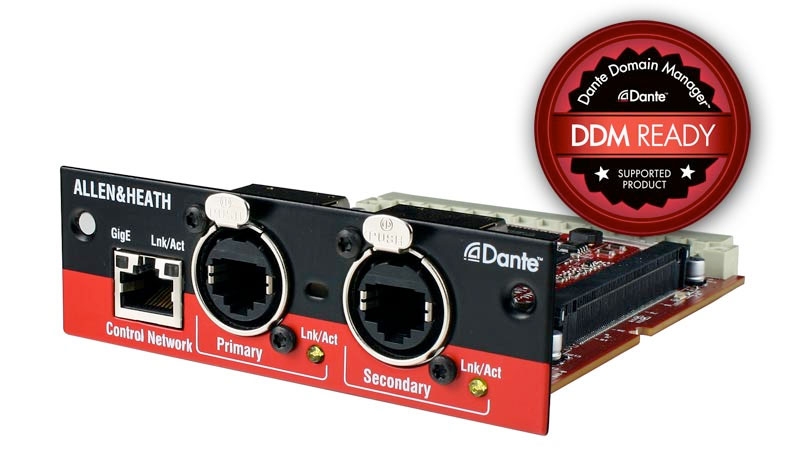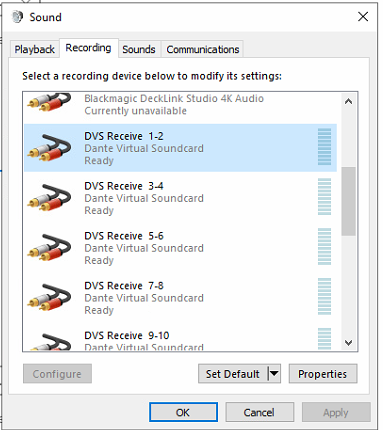
The only protocols, other than TCP and UDP, that I use (allow) is NFS over TCP so that I also benefit from TCP's acknowledgement feature as well as allowing me to route and receive traffic from outside my local Network. SAMBA/CIFS and other Microsoft protocols are banned on my Network because they are far too chatty, consuming precious bandwidth, which I rather need for my regular networking activities.

Note: Using a 100 mbit USB network adaptor for Dante in Windowz 10 is problematic because of the inefficient way that Microsoft handles network resources.

It appears to me that your new build suffers from some or other computing bottleneck which when resolved should also fix your Dante sound.Īlso check that your sample rate that your Dante devices/software uses matches that of your respective audio device. Multicast packets reduce computing overhead quite significantly. Your Dante ethernet ports are not running in energy efficient modeĪnd that you test using multicast packets to see if that makes a difference. In your case I would therefore suggest to check that: My Dante traffic is usually "injected" into the network in multicast mode. In addition I use a 2nd USB 100 megabit Ethernet adapter on my workstations dedicated exclusively for my Dante packetised audio traffic as well a the Dante controller. I do however still use the onboard sound for normal alerts. My workstation "hacks" are equipped with ESI's MAYA44e or MAYA44ex add on sound cards which I prefer above the normal onboard solution integrated on the respective mobos.
Dante virtual soundcard not detected software#
I have been using a number of Dante AIO devices as well as Audinate's VSC and VIA software solutions for quite a number of years and without problems, all on a cat 6 based gigabit ethernet backbone using unmanaged switches. Thanks in advance for any advise and guidance. Does this contribute to the problem?Īs I have my second LAN Card, is there any way to disable completely the RTL onboard LAN Card (therefore not having the RTL kext) and define my add-on Intel LAN Card as builtin? Is this also the way the LAN card is described in the real iMac? Referring to my Thinkpad laptop, the LAN card is registered under => AppleACPIPCI => IGBE => IntelMausi => en0. One note, the LAN Card of RTL8111 in the IO Registry plane is under => AppleACPIPCI => => IOPP => => RTL8111 => en0. Anyone maybe can share his thought on where should I look further for this issue? I tried to search through google for this symptom but not found any lead, therefore it is a specific problem. At first I thought it is because the RTL LAN Chip (different with the Intel chip used in both Thinkpad laptops), so I put a second LAN Card Intel I210 which is natively recognized by macOS and runt he DVS and all the other Dante source through this second network card. As well, the hackintosh is not worthy to be used for any other purpose.Ĥ. This makes all the system becomes laggy and the sound from Dante input cannot be used.

become laggy, and by Activity Monitor I see that kernel_task is active and having load to 100% at single core, moving from one core to another.

Whenever another Dante source is present in the network, the hackintosh start to behave abnormally, i.e. If there is no other Dante source in the network, the system works normal.ģ. DVS runs correctly in the en0 and it is also recognized correctly in the Dante Controller.Ģ. Now, I have another build based on Gigabyte Z390UD board, i9-9900K, Radeon 5500XT with onboard RTL8111 LAN recognized as en0 and builtin, iMac19,1 which not able to run the Dante with the following symptom:ġ. Running smoothly for audio recording multi track purpose. I previously ran Dante system using 2 different hackintosh based on Thinkpad laptop, one a T440 Haswell and other one a T460s Skylake both with Intel LAN card without any problem. Building a CustoMac Hackintosh: Buyer's GuideĪnybody here has experience running Dante System (specifically, Dante Virtual Soundcard and Dante Controller) in a hackintosh, specifically an iMac Hackintosh?


 0 kommentar(er)
0 kommentar(er)
